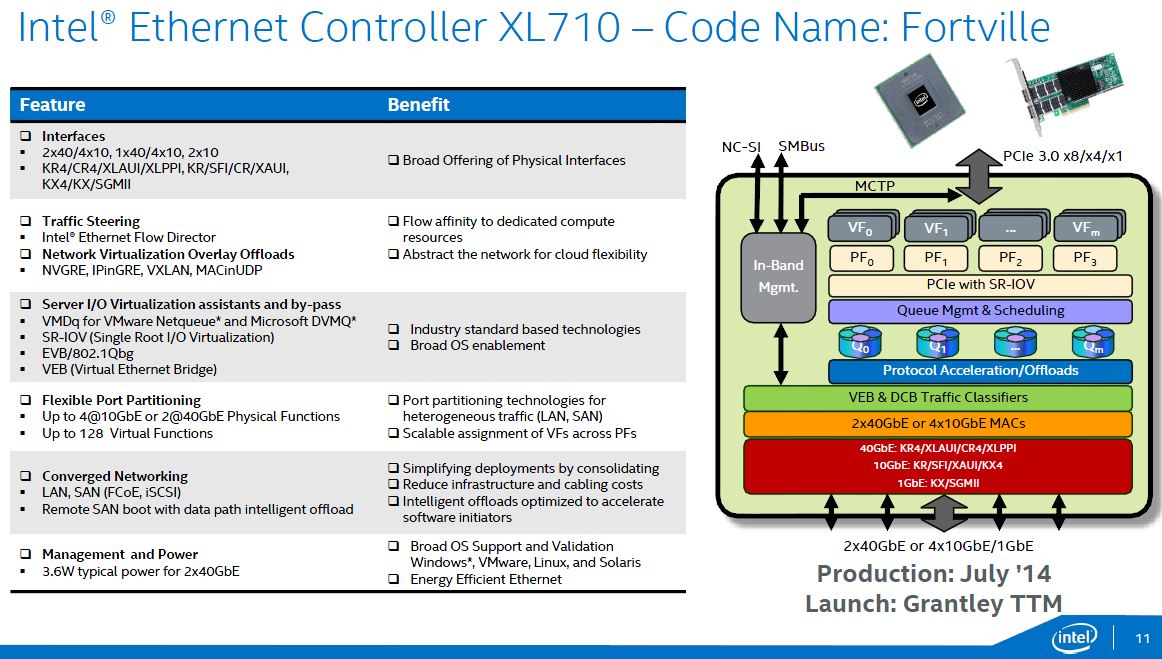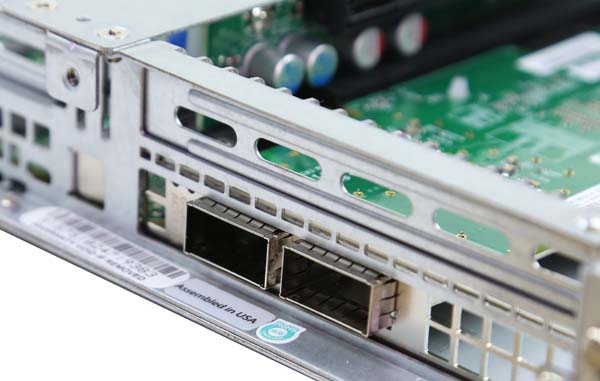Intel Xeon E5-2600 V3 Review: Haswell-EP Redefines Fast
Fortville: 40 GbE Ethernet For The Masses
Alongside the Grantley platform, Intel is introducing a new generation of Ethernet network adapters code-named Fortville. The controller is 40 Gb-capable, and it completely changes the game with regards to Intel's networking capabilities.
Given the massive performance increases enabled by today's systems, low-latency and high-bandwidth networking is essential. Grantley is built to consolidate an even greater number of virtual machines on a single server. Technologies like VMware vSAN utilize local storage to create distributed SANs for these virtual machines. Even trends like software-defined networking can benefit from higher port counts and greater networking performance. Fortville is Intel's solution.
There are three main configurations of the Fortville adapter: 2 x 40 GbE, 1 x 40 GbE, and 2 x 10 GbE. Compare that to the previous generation of Spring Fountain-based X520 adapters capable of up to 2 x 10 GbE. You quickly see the bandwidth "potential" goes up from 20 to 80 Gb/s on the Fortville X710 family.
While a 4x bandwidth increase sounds awesome, that ceiling is currently not possible to hit. Servers generally expose a bunch of eight-lane PCIe slots. Right now, the third-gen standard gives you a little less than 8 GB/s of throughput. Furthermore, there is always some overhead involved. So, hooked up to the Cray-Gnodal GS0018 (18 x 40 GbE) switch in the lab, we are seeing between 50 and 55 Gb/s of peak bandwidth. We dno't have enough data to publish formal numbers. However, there is definitely a bottleneck in play.
Still, in most deployments, the two QSFP ports will attach to different switches for failover. And there's plenty of headroom in the card to drive essentially a full 40 Gb connection, plus a solid amount through the second port.
Another aspect of 40 GbE-based products like the XL710 is that each QSFP port can utilize QSFP-to-4x SFP+ breakout cables. This allows for each XL710 card with dual QSFP ports to connect to up to 8x SFP+ 10 GbE devices. In theory, you can place eight of these dual-port cards in a server and then use that machine with 72 10 GbE network connections. The reasons not to are pretty obvious, but it's at least technically possible.
The other side of the Fortville story, aside from the controller's huge performance and density improvements, is power consumption. Fortville uses less power than the previous-gen X520 10 GbE adapters, both at idle and under load. The X520s had an 8.6 W TDP, while the XL710 generation is rated at 7 W. In a theoretical efficiency metric, Fortville delivers more than 3.5 times the throughput/watt compared to previous generation. That is a massive leap forward. Consistent with this, Fortville is rated at 3.6 W typical power consumption using two 40 GbE links, so 7 W TDP represents a lot of headroom.
Get Tom's Hardware's best news and in-depth reviews, straight to your inbox.
At the end of the day, Intel's Fortville-based adapters should enable more bandwidth, lower latency, and higher port density, all at reduced power consumption.
Current page: Fortville: 40 GbE Ethernet For The Masses
Prev Page Meet Intel's Grantley Platform Next Page How We Tested-
CaptainTom Wonder how long it is until 18-core CPU's are utilized well in games...Maybe 2018 or 2020?Reply -
dovah-chan ReplyCaptain Tom said:Wonder how long it is until 18-core CPU's are utilized well in games...Maybe 2018 or 2020?
Actually we should be trying to move away from traditional serial-styled processing and move towards parallel processing. Each core can handle only one task at a time and only utilize it's own resources by itself.
This is unlike a GPU, where many processors utilize the same resources and perform multiple tasks at the same time. The problem is that this type of architecture is not supported at all in CPUs and Nvidia is looking for people to learn to program for parallel styled architectures.
But this lineup of CPUs is clearly a marvel of engineering and hard work. Glad to see the server industry will truly start to benefit from the low power and finely-tuned abilities of haswell along with the recently introduced DDR4 which is optimized for low power usage as well. This, combined along with flash-based storage (aka SSDs) which also have lower power drain than the average HDD, will slash through server power bills and save companies literally billions of dollars. Technology is amazing isn't it? -
2Be_or_Not2Be There is still a lot in games that doesn't translate well into parallel processing. A lot of gaming action only happens as a direct result of the user's input, and it usually triggers items that are dependent upon the results from another item. So parallel processing doesn't help a lot there; single-threaded performance helps more.Reply
However, with multiple cores, now we can have better AI and other "off-screen" items that don't necessarily always depend upon the user's direct input. There's still a lot of work to be done there, though. -
2Be_or_Not2Be The new Haswell-EP Xeons are definitely going to help with virtualization. However, I see the high-price of DDR4 and the relative scarcity of it now as being a bit of a handicap to fast adoption, especially since that is one of the major limiting factors to how many servers you can virtualize.Reply
I think all of the major server vendors are going to suck up all of the major memory manufacturers DDR4 capacity for a while before the prices go down. -
balister ReplyThe new Haswell-EP Xeons are definitely going to help with virtualization. However, I see the high-price of DDR4 and the relative scarcity of it now as being a bit of a handicap to fast adoption, especially since that is one of the major limiting factors to how many servers you can virtualize.
I think all of the major server vendors are going to suck up all of the major memory manufacturers DDR4 capacity for a while before the prices go down.
Whether it helps or hinders will ultimately depend on the VM admin. What most VM admins don't realize is that HT can actually end up degrading performance in virtual environments unless the VM admin took specific steps to use HT properly (and most do not). A lot of companies will tell you to turn off HT to increase performance because they've dealt with a lot of VM admins that don't set things up properly (a lot of VM admins over allocate which is part of the reason using HT can degrade performance, but there are other settings as well that have to be set in the Hypervisor so that the guest VMs get the resources they need). -
InvalidError Reply
This is easier said than done since there are tons of everyday algorithms, such as text/code parsing, that are fundamentally incompatible with threading. If you want to build a list or tree using threads, you usually need to split the operation to let each thread work in isolated parts of the list/tree so they do not trip over each other and waste most of their time waiting on mutexes and at the end of the build process, you have a merge process to bring everything back together which is usually not very thread-friendly if you want it to be efficient.14133592 said:Actually we should be trying to move away from traditional serial-styled processing and move towards parallel processing. Each core can handle only one task at a time and only utilize it's own resources by itself.
In many cases, trying to convert algorithms to threads is simply more trouble than it is worth. -
Rob Burns Great to see these processors out, and overall good article. I only wish you used the same benchmark suite you had for the Haswell-E processors: 3DS Max, Adobe Premiere, After Effects, Photoshop. I'd also love to see Vray added to the mix. Not much useful benchmark data in here for 3D professionals. Some good detail on the processors themselves however.Reply -
Drejeck ReplyWonder how long it is until 18-core CPU's are utilized well in games...Maybe 2018 or 2020?
Simply never.
A game is made by sound, logic and graphics. You may dedicate this 3 processes to a number of cores but they remain 3. As you split load some of the logic must recall who did what and where. Logic deals mainly with FPU units, while graphics with integers. GPUs are great integers number crunchers. They have to be fed by the CPU so an extra core manage data through different memories, this is where we start failing. Keeping all in one spot, with the same resources reduces need to transfer data. By implementing a whole processor with GPU, FPU, x86 and sound processor all in one package with on board memory makes for the ultimate gaming processor. As long as we render scenes with triangles we will keep using the legacy stuff. When the time will come to render scenes by pixel we will need a fraction of today's performance, and half of the texture memory (just scale the highest quality) and half of models memory. Epic is already working on that.
-
pjkenned ReplyGreat to see these processors out, and overall good article. I only wish you used the same benchmark suite you had for the Haswell-E processors: 3DS Max, Adobe Premiere, After Effects, Photoshop. I'd also love to see Vray added to the mix. Not much useful benchmark data in here for 3D professionals. Some good detail on the processors themselves however.
Great points. One minor complication is that the NVIDIA GeForce Titan used in the Haswell-E review would not have fit in the 1U servers (let alone be cooled well by then.) Onboard Matrox G200eW graphics are too much of a bottleneck for the standard test suite.
On the other hand, this platform is going to be used primarily in servers. Although there are some really nice workstation options coming, we did not have access in time for testing.
One plus is that you can run the tests directly on your own machine by booting to a Ubuntu 14.04 LTS LiveCD, and issuing three commands. There is a video and the three simple commands here: http://linux-bench.com/howto.html That should give you a rough idea in terms of performance of your system compared to the test systems.
Hopefully we will get some workstation appropriate platforms in the near future where we can run the standard set of TH tests. Thanks for your feedback since it is certainly on the radar.

